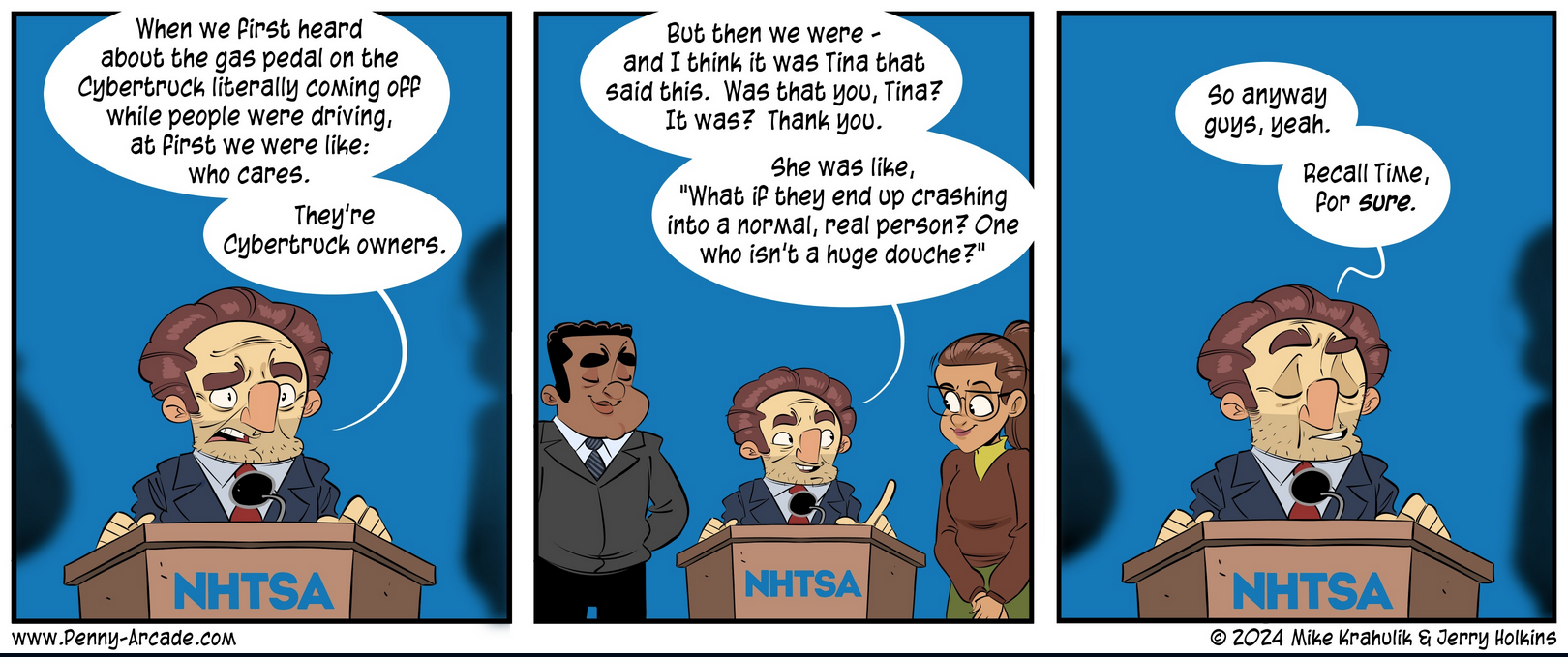- 0 Posts
- 43 Comments
That was actually the rest of the comic:


 44·3 months ago
44·3 months agoThere is a Unicode Technical Standard for this, called the Unicode Collation Algorithm. Whether everyone uses it, I can’t say. As it says on the linked page:
Conformance to the Unicode Standard does not imply conformance to any UTS.
So in other words it’s possible to conform to the Unicode Standard without adhering to the Unicode Collation Algorithm.
whatever this is: ¦
That is the pipe symbol, or vertical bar. When it has a gap in the middle it may be known as the broken pipe symbol or broken bar. It’s considered the same symbol with or without the gap. Early terminals displayed it with a gap to make it distinguishable from lower-case L characters.

 42·4 months ago
42·4 months agoSumming a balance column is never correct. Take any example that doesn’t end in a zero balance and it’s easy to see that the balance column’s sum is meaningless:

They might taste terrible, but the net benefits to society would be grrreat!


 5·5 months ago
5·5 months agoWhen I fly to the US from Toronto I clear US customs in Pearson Airport, before getting on the plane. If I were to sign up for a Nexus pass I’d be able to pass through US customs even faster, but I don’t travel often enough for it to be worthwhile. Not sure if either of those matches what you mean by pre-clearance.

 14·5 months ago
14·5 months agoThere are some viruses that have targeted Linux, but they’re rare compared to other platforms and their ability to spread is relatively low. One of the main reasons is just down to how software tends to be installed on each platform. Viruses have an easier time spreading on Windows or OSX where users are more accustomed to downloading an executable and running it. Once there’s a malicious running process, it has a comparatively high chance to spread because it can attempt to escalate its privileges either by exploiting a bug or socially engineering the user to click through a privilege escalation prompt. That entire workflow is practically nonexistent on Linux, users just don’t tend to download and execute random binaries. Instead most Linux software gets delivered in one of these ways, each of which has impediments that reduce the chance a virus could spread:
- through an OS repo; it would be difficult for a malicious actor to get a virus through the release process and into a trusted repo
- through a public source like Github; again it would be difficult for a malicious actor to get a virus into public source code without someone noticing
- through a container image from an image library like DockerHub; I believe a malicious container would be sandboxed, making it hard if not impossible for that container to take over the host system
- through an application image like a snap, flatpak or appimage; again, I believe these run in their own sandbox from which they would have difficulty breaking out
There are some exceptions, for example some companies like Hashicorp will distribute their stuff as precompiled binaries. Even in that case you’re probably fine as long as you don’t run the downloaded binary as root. Users in the habit of downloading strange binaries from sketchy places and running them as root just aren’t very common among the Linux userbase. I’m sure there are some (and they should really stop doing that), but there aren’t enough of them to allow a virus to spread unchecked.

 451·5 months ago
451·5 months agoI don’t think dedicated antivirus software is really required anymore. I haven’t run third-party AV software on any of my systems in the last decade.
On Windows, the built-in Windows Defender is good enough for most use cases. When it first launched Defender had a pretty bad track record at stopping viruses, but now it routinely ranks at the top.
On Linux, antivirus software has never really been required. One major exception I can think of would be if you’re running a file server or mail server that talks to OSX or Windows systems. Even then the AV software isn’t really there to protect the server, it’s there to make sure you don’t pass malware or viruses to those non-Linux clients.

 6·5 months ago
6·5 months agoI didn’t say I’d downvote in those situations. I would guess that Rule 5 needs to exist for a reason. Without it the community could get overrun with ragebait posts. Personally I wouldn’t consider any of your examples questions to be ones that violate Rule 5, but I’m not a mod and I don’t make or enforce the rules. I also wouldn’t downvote such a question myself, but I would consider reporting it if it seemed like the OP was consistently trying to pull the conversation into fractious territory. Anyway, if we want to to discuss the rules and downvoting vs. reporting, that should probably go in a meta post.

 4·5 months ago
4·5 months agoI know, I couldn’t resist the urge to make a Lionel Hutz reference.

 431·5 months ago
431·5 months agoSerious answer, the question might be one that broke one of the community rules like Rule 5 (“No baiting or sealioning or promoting an agenda”) or Rule 6 (No meme or troll questions, except on Fridays) and voters are expressing their displeasure.
Silly answer, the question wasn’t stupid. The name of the community is actually “No, Stupid Questions.” The missing comma is a typo.

 3·5 months ago
3·5 months agoWhat an odd coincidence… I’ve been following this boat-building channel on Youtube for a couple years, and they talked about wood grain in the episode posted just today. Here’s a link to the relevant timestamp in the video. I’m not a woodworking expert by any means, but if the boat people say tighter grain is better I’ma believe 'em.

 34·5 months ago
34·5 months agoThis shit has been going on since the 80s. It’s mostly bullshit instigated by US lumber companies. Available softwood lumber in the US is mainly on privately owned land, and the owners of that land want the price of lumber to be as high as possible so they can make more money. The softwood lumber companies in the US are effectively acting as an oligopoly, and they lobby US politicians for legislation in their interests.
Softwood lumber in Canada is mainly on public land, called “crown land” here in Canada. A lumber oligopoly isn’t possible in Canada because the government would never sell all of that land to a handful of lumber companies. Instead lumber producers in Canada are charged a fee for the logs they cut, that fee is set by the Canadian government, and it is less per log than what US lumber producers want to charge.
Instead of competing on price, US lumber companies lobby congress to impose softwood lumber tariffs for the umpteenth time. When the US lumber companies don’t need to compete with Canadian lumber, they can jack up their prices. When they do that the only people who benefit are the US lumber companies and the politicians they’ve lobbied. Americans pay more for lumber, Canadian lumber companies and their workers suffer.

 211·6 months ago
211·6 months agoApparently the technical term is protein poisoning. Digesting protein creates urea, and the body needs at least some fat in order to convert to ammonia that can be excreted. It’s also called “mal be caribou” in French (caribou sickness, I think), which I find fascinating.

 11·6 months ago
11·6 months agoHow did this happen? Isn’t there usually a flight attendant standing right there as you board the plane?
Yes, but the 777 has two aisles. Here’s the Air Canada seat map. The flight attendant greeting passengers would be by the first aisle, directing passengers down the correct aisle for their seat. This passenger might have been directed to the second aisle, and rather than turning down the aisle they went straight across to opposite exit door. Or they might have used one of the other doors. The 777 has 10 full-sized doors, 5 on each side of the plane. Two of those doors open onto the wings, one of those would have been used for boarding, maybe two if first-class passengers get a separate air bridge, but that still leaves 6 or 7 doors where there isn’t likely to be a flight attendant to notice a passenger doing something stupid.

 121·6 months ago
121·6 months agoRemoved by mod



One of my grandfathers worked for a telephone company before he passed. That man was an absolute pack rat, he wouldn’t throw anything away. So naturally he had boxes and boxes of punch cards in this basement. I guess they were being thrown out when his employer upgraded to machines that didn’t need punch cards, so he snagged those to use as note paper. I will say, they were great for taking notes. Nice sturdy card stock, and the perfect dimensions for making a shopping list or the like.